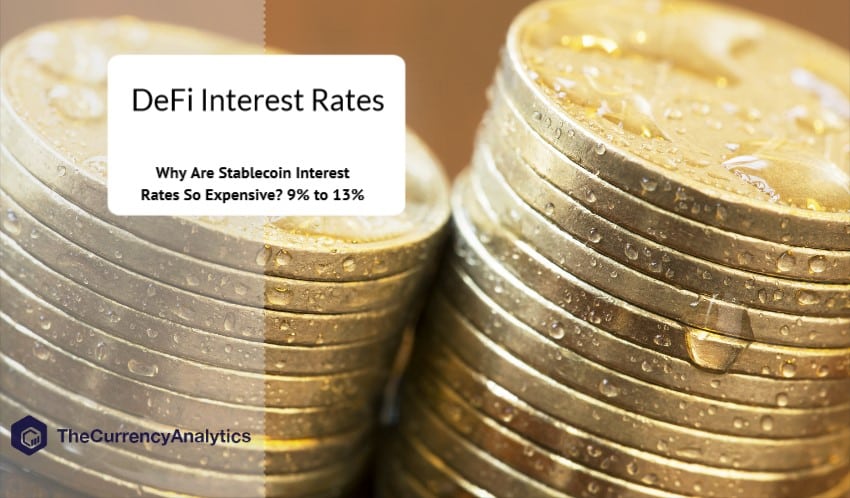
Why are dollar-pegged stablecoin interest rates so much higher than interest rates on genuine dollars? You’d imagine that a stablecoin for a $1 would have the same interest rate as a dollar, which is zero. However, a cursory search for stablecoin loan rates finds rates ranging from 9% to 13%, or possibly more.
The simple argument is that high interest rates compensate individuals for the chance that the stablecoin would depreciate. However, premier stablecoins like as USDC and Pax (USDP) are entirely backed by high-quality dollar assets, thus the chance of consumers losing their money is low. No, there is another explanation — and it reveals a fundamental incompatibility in the uses of stablecoins.
We understand why interest rates on real money are so low. Because the Federal Reserve has reduced interest rates to zero, banks have no incentive to pay interest on deposits. And since the Fed has created billions of additional dollars, there are considerably more cash dollars floating in traditional markets than anybody can consume. Dollars aren’t in demand, thus they don’t command any interest.
In the case of stablecoins, however, the opposite is true. The demand for stablecoins is always greater than the supply. As a result, persons having stablecoins to lend might demand higher interest rates, while crypto platforms thirsty for stablecoins can offer higher interest rates to entice new stablecoin lenders. That is why the interest rates on stablecoins are so high. It’s just basic economics.
You’d expect that stablecoin issuers would print enough coins to meet demand. After all, there are no restrictions for stablecoin issuance. At the click of a button, stablecoins may be generated out of thin air. They are the crypto counterpart of quantitative easing (QE), without the asset purchases. Indeed, stablecoin producers have been churning out new coins at an alarming pace. Jeremy Allaire, on the other hand, cannot reduce interest rates by printing billions of USDC. The market just consumes what he prints and returns for more. Where does all of this demand come from?
Exchanges are the most apparent location. Stablecoins provide excellent liquidity for cryptocurrency exchanges. They let consumers to simply and swiftly move in and out of cryptocurrencies without incurring losses on the bridge asset. As the popularity of cryptocurrencies grows, so does the need for stablecoins. To keep trading activity going, a rising exchange like FTX need ever-increasing amounts of stablecoin liquidity. Without these injections, it would have to either limit stablecoin trading or allow stablecoins to deviate from their dollar pegs during times of great demand.
Stablecoins also provide crypto investors a “safe haven” when cryptocurrency prices are volatile. As a result, when cryptocurrencies experience a wild ride, as they have in recent months, demand for stablecoins surges. This tends to knock them off their perches, thereby destroying their function. Jeremy Allaire cranks up the printing presses when people are cashing out of risky crypto into lovely, secure stablecoins and USDC is beginning to seem costly.
However, although printing additional stablecoins keeps them stable when demand is great, it does not lower interest rates on stablecoin loans. In this regard, stablecoin issuers differ from central banks. The goal of central banks is to keep interest rates under control. Issuers of stablecoins only have control over exchange rates. Interest rates increase when money is printed to maintain an exchange rate peg. As a result, Jeremy’s printing adds to the high interest rates on stablecoins.
However, this is not the sole cause. Stablecoins are in high demand — and it isn’t coming from exchanges. It is derived from decentralized finance.
Stablecoins tied to the US dollar are utilized as primary collateral in DeFi lending and staking pools. As more individuals become involved in DeFi and new platforms emerge, the need for stablecoins as collateral grows tremendously. In December, The Block reported that stablecoin issuance has increased 388 percent in a year, owing mostly to DeFi demand. If this trend continues, demand for stablecoins as collateral may outnumber their usage as secure assets on exchanges.
Now that extended rehypothecation chains have been eliminated, traditional markets have become dependent on liquidity injections from central banks. The Fed has even devised a liquidity pump: it lends dollars to banks in exchange for pledged securities (the “standing repo facility,” or SRF), and securities to non-banks in exchange for dollars (the “overnight reverse repos,” or ON RRP). The goal is to keep interest rates under control. The Fed will not let them to fall through the floor or soar to the levels attained by stablecoin interest rates.
The cryptocurrency community opposes both central bank intervention in markets and the regulations that make it necessary. As a result, it’s not surprise that crypto lenders are looking for methods to make collateral liquid. And, whether they realize it or not, they are reaching for the same instruments. Rehypothecation has returned. Lending platforms such as Celsius use rehypothecation to generate high returns for their depositors: Celsius has been accused of “endlessly rehypothecating” pledged assets, which it denies.
However, rehypothecation with DeFi is currently a minor issue. Constant infusions of new stablecoins are the only significant relief from the terrible illiquidity that results from feeding crypto’s main medium of exchange to the derivatives monster’s ever-hungry appetite. That is why Jeremy Allaire is unable to quit printing.



Get the latest Crypto & Blockchain News in your inbox.